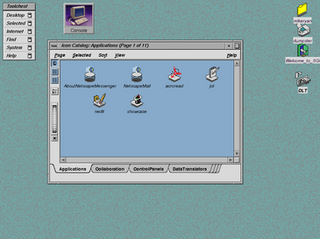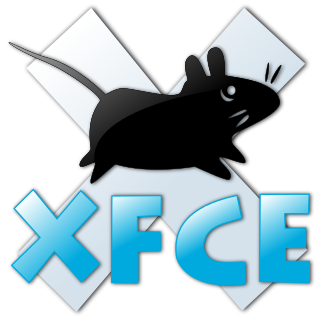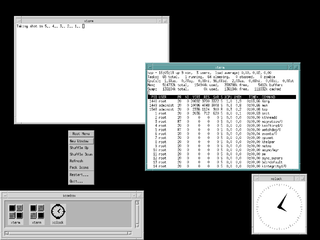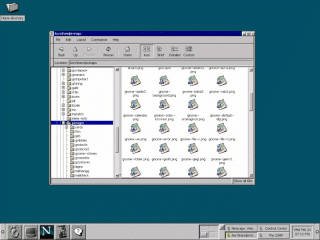
IRIX is a discontinued operating system developed by Silicon Graphics (SGI) to run on the company's proprietary MIPS workstations and servers. It is based on UNIX System V with BSD extensions. In IRIX, SGI originated the XFS file system and the industry-standard OpenGL graphics system.

KornShell (ksh) is a Unix shell which was developed by David Korn at Bell Labs in the early 1980s and announced at USENIX on July 14, 1983. The initial development was based on Bourne shell source code. Other early contributors were Bell Labs developers Mike Veach and Pat Sullivan, who wrote the Emacs and vi-style line editing modes' code, respectively. KornShell is backward-compatible with the Bourne shell and includes many features of the C shell, inspired by the requests of Bell Labs users.

Solaris is a proprietary Unix operating system originally developed by Sun Microsystems. After the Sun acquisition by Oracle in 2010, it was renamed Oracle Solaris.
In computing, a desktop environment (DE) is an implementation of the desktop metaphor made of a bundle of programs running on top of a computer operating system that share a common graphical user interface (GUI), sometimes described as a graphical shell. The desktop environment was seen mostly on personal computers until the rise of mobile computing. Desktop GUIs help the user to easily access and edit files, while they usually do not provide access to all of the features found in the underlying operating system. Instead, the traditional command-line interface (CLI) is still used when full control over the operating system is required.

Xfce or XFCE is a free and open-source desktop environment for Linux and other Unix-like operating systems.

In computing, Motif refers to both a graphical user interface (GUI) specification and the widget toolkit for building applications that follow that specification under the X Window System on Unix and Unix-like operating systems. The Motif look and feel is distinguished by its use of rudimentary square and chiseled three-dimensional effects for its various user interface elements.

Java Desktop System, briefly known as OpenSolaris Desktop, is a legacy desktop environment developed first by Sun Microsystems and then by Oracle Corporation after the 2010 Oracle acquisition of Sun. Java Desktop System is available for Solaris and was once available for Linux. The Linux version was discontinued after Solaris was released as open source software in 2005. Java Desktop System aims to provide a system familiar to the average computer user with a full suite of office productivity software such as an office suite, a web browser, email, calendaring, and instant messaging.

Unix System V is one of the first commercial versions of the Unix operating system. It was originally developed by AT&T and first released in 1983. Four major versions of System V were released, numbered 1, 2, 3, and 4. System V Release 4 (SVR4) was commercially the most successful version, being the result of an effort, marketed as Unix System Unification, which solicited the collaboration of the major Unix vendors. It was the source of several common commercial Unix features. System V is sometimes abbreviated to SysV.

A pluggable authentication module (PAM) is a mechanism to integrate multiple low-level authentication schemes into a high-level application programming interface (API). PAM allows programs that rely on authentication to be written independently of the underlying authentication scheme. It was first proposed by Sun Microsystems in an Open Software Foundation Request for Comments (RFC) 86.0 dated October 1995. It was adopted as the authentication framework of the Common Desktop Environment. As a stand-alone open-source infrastructure, PAM first appeared in Red Hat Linux 3.0.4 in August 1996 in the Linux PAM project. PAM is currently supported in the AIX operating system, DragonFly BSD, FreeBSD, HP-UX, Linux, macOS, NetBSD and Solaris.

OpenWindows is a discontinued desktop environment for Sun Microsystems workstations which combined a display server supporting the X Window System protocol, the XView and OLIT toolkits, the OPEN LOOK Window Manager (olwm), and the DeskSet productivity tools; earlier versions of OpenWindows also supported the NeWS protocol. It implements the OPEN LOOK GUI specification.
The following tables compare general and technical information between a number of notable IRC client programs which have been discussed in independent, reliable prior published sources.
In computing, Sharity is a program to allow a Unix system to mount SMB fileshares. It is developed by Christian Starkjohann of Objective Development Software GmbH and is proprietary software. As of 8 November 2010, the current version is 3.9.

GNOME Keyring is a software application designed to store security credentials such as usernames, passwords, and keys, together with a small amount of relevant metadata. The sensitive data is encrypted and stored in a keyring file in the user's home directory. The default keyring uses the login password for encryption, so users don't need to remember another password.
GNU variants are operating systems based upon the GNU operating system. According to the GNU project and others, these also include most operating systems using the Linux kernel and a few others using BSD-based kernels.

A Unix-like operating system is one that behaves in a manner similar to a Unix system, although not necessarily conforming to or being certified to any version of the Single UNIX Specification. A Unix-like application is one that behaves like the corresponding Unix command or shell. Although there are general philosophies for Unix design, there is no technical standard defining the term, and opinions can differ about the degree to which a particular operating system or application is Unix-like.

Unix is a family of multitasking, multi-user computer operating systems that derive from the original AT&T Unix, whose development started in 1969 at the Bell Labs research center by Ken Thompson, Dennis Ritchie, and others.

MATE is a desktop environment composed of free and open-source software that runs on GNU with Linux, and other Unix-like operating systems such as BSD, and illumos operating systems.

ProFTPD is an FTP server. ProFTPD is Free and open-source software, compatible with Unix-like systems and Microsoft Windows . Along with vsftpd and Pure-FTPd, ProFTPD is among the most popular FTP servers in Unix-like environments today. Compared to those, which focus e.g. on simplicity, speed or security, ProFTPD's primary design goal is to be a highly feature rich FTP server, exposing a large amount of configuration options to the user.

GNOME 1 is the first major release of the GNOME desktop environment. Its primary goal was to provide a consistent user-friendly environment in conjunction with the X Window System. It was also a modern and free and open source software alternative to older desktop environments such as the Common Desktop Environment (CDE), but also to the K Desktop Environment (KDE). Each desktop environment was built-upon then proprietary-licensed widget toolkits, whereas GNOME's goal from the onset, was to be freely-licensed, and utilize the GTK toolkit instead.



















